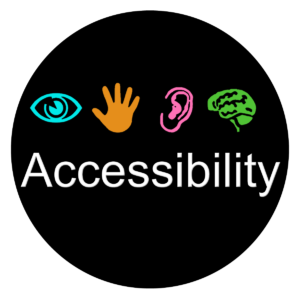What does Access Look Like?
Access looks different depending on the individual. For my cousin with dyslexia access looks like short interpretation using simple language and maybe audio guides. To my deaf friend access means subtitles, ASL or BSL interpretation, and staff who also speak ASL/BSL. For me access looks like no sudden loud noises, no bright lights, and no strong smells.
Access for school children is different than access for seniors. For children it can mean bright, exciting, new information with a picnic area and tactile interactives. For seniors it might mean calm, seated art appreciation or object handling sessions.
Access means different things for different people. What it doesn’t mean, however, is the law. Accessibility laws are the bare minimum needed to create a space that is accessible. I read this a few years ago and the trickiness of social media means I cannot attribute it, if you know who posted this please let me know and I will give proper credit: “If your store has a ramp and isle wide enough for a wheelchair but you put a display in the middle of the isle it is not accessible.” If you follow the law it means a disabled person can enter your space.
It does not mean a disabled person can experience your space.
This is part of why community consultation is so important. I am not a wheelchair user. My needs are not the same as a wheelchair user. I do not know if the tile in the small gallery will cause an issue. I can reasonably assume the wrinkles in the old carpet are a hazard but I don’t know.
What does Access Mean to My Museum?
Access can mean different things to different museums. For example the Egypt Centre in Swansea wanted to create access for children who struggle academically and/or emotionally. So they developed the Young Egyptologist Workshops which are separate from their regular children’s workshops.
The Royal Ontario Museum wanted to create access for Native Americans while also promoting greater understanding between white/colonial Canadians and our indigenous people so the museum opened up the First People’s Gallery for free access and consulted with indigenous people to ensure an accurate portrayal of the country’s history.
Your museum may be in the same area as a school for the blind. In that case access might mean having described tours, raised lettering on signage, ensuring your facilities are service dog positive. It might mean keeping your museum to a single story where possible or focusing on handling boards for interactives.
Only your Community
Only your own museum community (or desired community) can determine what access means to you. I can help you with contacting that community or brainstorming ideas but if access is your goal you must consult with your community.
You do not have a choice. Without consultation your representation will be flawed. When writing access webpages, for example, something that you don’t think is important to include such as gallery guides, might be very important to your audience with learning disabilities.
One thing I would not have thought of including in Autism guides is the source of noises in galleries. It did not occur to me that some autistic people would be confused and distressed by the noise of an old HVAC system. And I’m autistic!
Access means many different things
Access looks like different things to different people. What does access look like to you?

